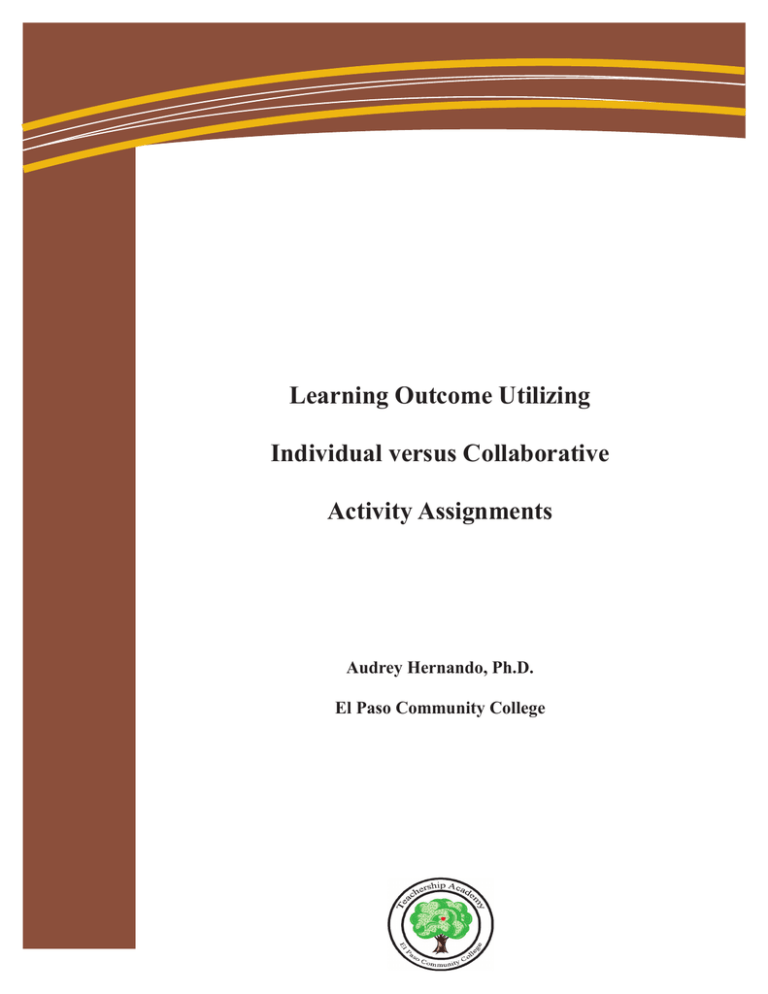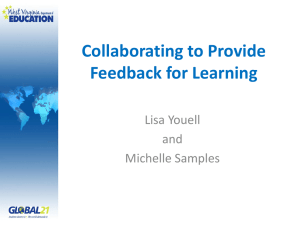Information Technology Solutions Learning Outcome Utilizing Individual versus Collaborative Activity Assignments
advertisement

Information Technology Solutions Learning Outcome Utilizing Individual versus Collaborative Activity Assignments Audrey Hernando, Ph.D. El Paso Community College ABSTRACT The importance of how students learn cannot be dismissed. Studies show that some students learn best using collaborative or cooperative methods. In my research, I plan on comparing classes that use collaborative learning versus non collaborative work. The same lectures and exercises will be used for both groups, two 1408 sections (non-majors) and two 1406 sections (majors). Grades were used to measure the student learning outcome. It was found that students who worked collaboratively performed better. INTRODUCTION Education is an important aspect for many. The quality of life we experience is often dependent on the amount and quality of the education we receive. Education changes us and (Fielding 2012) allows us to have resources and security. When asked, 9 out of 10 people feel that learning makes a positive difference in improving their quality of life (Bariso 2008). Education can break the link from where we come and our chance to succeed (Sawhill 2006). Learning throughout our life is key to the development of our purpose in life (Fielding 2012). In the United States, only 28% of the population is scientifically literate. This is the case, only because biology is a requirement in many colleges (MSU 2007). Fifty percent of first year college students do not have the ability to reason and succeed in biology (Daempfle 2006). Science clearly plays a strong role in our everyday lives. As technology advances we are constantly using electronics; everything from computers to cell phones. It is important to understand the implications of using this equipment. We receive instantaneous gratification from the use of technology and for many are used several hours daily. In addition, we need to appreciate the value of education in making the correct choices politically regarding the health our environment, stem cell utilization, the safety of our drinking water, and the implications in the use of nuclear energy, as well as, many other issues (MSU 2007). Medically we need to understand different health concerns; the constant bombardment of medications we’re prescribed and buy over the counter. What are the implications of mixing the medications we take? What do we really know about the food products we consume? In order to make good decisions, these issues require that we be literate and educated. Many educators, don’t utilize one of their most important resources, their own students. Collaborative learning is one way we, as educators, can utilize this powerful tool. Collaborative learning, a form of active learning, can be described, as an educational method used by combining small groups of students with a variety of abilities to work together on a project with a collective purpose. Each student contributes their own strengths to the group. This form of learning makes the students not only responsible for their own learning but each other’s as well (Gokhale 1995). It is one way that has been found to be effective in learning different skills. Working as a cooperative group enhances leadership, communication, decision making, trust building and conflict resolution skills (Univ. Minn. 2012). In addition, critical thinking is enhanced when working in small groups. A study done by Anuradha Gokhale found that students working with peers were able to adopt knowledge and critical thinking skills from other students. They were then able to use this knowledge to improve their own cognitive skills (Gokhale 1995). Traditional classes taught using lectures encourage passive learning. Collaborative learning allows students to use develop reasoning skills rather than remain as passive learners (Daempfle 2006). Collaborative learning takes up valuable time that could otherwise be used for coverage of lecture material and could cause some fear among educators resulting in a static or unchanging method of teaching to be continued to be utilized (Daempfle 2006). While it is true that students need to learn different background material such as jargon and biological concepts (Bergtrom 2011), there is a place for collaborative learning in the classroom setting. Cooperative learning can provide many positive outcomes. It has been found to improve student achievement, reasoning, and there is long term memory of the material covered Students also learn to socialize, a skill many employers covet. Self-esteem and confidence levels are also a benefit for the participants (Univ. Minn. 2012) HYPOTHESIS & PURPOSE OF STUDY The question asked is, how can students be taught to not only memorize the lesson but actually learn the material. I believe that collaborative learning will result in a positive impact on leaning outcome. I want to practice this method to determine if collaborative learning will benefit the students learning outcome. Many of our students are non-traditional students who have been out of school for an extended time and return with many insecurities but a great deal of life experiences. On the other end of the spectrum, are high school students, working on their college degrees. Although they have many of the study skills that are helpful for their success, they lack life experience and background that can enhance their learning experience and learning outcome. Since some of our students need extra help, I believe combining students of different backgrounds to work collaboratively can help all the students in the group. METHODOLGY During the spring 2013 semester, 4 classes were selected for this project. Research was conducted on two sections of General Biology, 1406, a major’s course designed for students majoring in science, and two sections of Introductory Biology, 1408, a non-majors course, for students majoring in a discipline other than science. Both courses are the first course of a series of course taken. The same lecture over the lesson material covered was given to both 1406 classes. Additional worksheets were assigned to both groups of classes so that both 1406 classes had the same material. The same protocol was followed for the 1408, Introductory Biology classes. Both open ended questions as well as multiple choice questions were on the worksheets. The difference was in one 1406 and one 1408 class, students worked collaboratively. The other 1406 and 1408 class the student worked individually. Both classes were then given a quiz and tested over the material. The grades are used to measure the learning outcome. In addition, exams and lab grades were used to evaluate the student learning outcome. The subjects ranged in age from 16 to older students in their 40’s enrolled in classes at El Paso Community College, El Paso, Texas. There are 30 students in each of the 1406 General Biology classes and 31 and 29 in the 1408 Introductory Biology classes. A total of 120 students participated in this research. LIMITATIONS Limitations of the research included the length of study, 3 months, and is based only on grades obtained soon after the lesson. Long term memory could not be measured. The study measured only students enrolled in biology classes and labs. RESULTS Results obtained are listed as follows for General Biology1406 (majors) for both students working individually and those working collaboratively. The overall averages indicate that the students that practiced collaborative learning had a higher overall average than the students that worked individually. The biology science class designed for students majoring in science that worked collaboratively had an overall average of 85.5 compared to those students who worked individually whose overall average was 83.53 (Table 1). Table 1: Grades for students enrolled in General Biology 1406, the major’s course. If the exams were averaged individually the same trend was noted. The students who worked collaboratively had an exam grade average of 78.38 compared to 75.36. The laboratory grades show the same trend, although group work is involved for all students, those students who worked collaboratively in class still outperformed those students who worked individually in class. Collaborative students had a laboratory average of 89.05 versus the students who worked individually with a laboratory average of 87.62. Students enrolled in the class designed for non-majors, Introduction to Biology, students who are majoring in something other than science showed the same trend as the results found in the majors, General Biology students. The overall average for the students who worked individually had an overall average of 88.5 compared to the collaborative study groups who earned an overall average of 90.8 (Table 2). The exam averages between the two classes showed a higher average for the collaborative class with an average of 80.72 compared to the class average for students that worked individually with an average of 77.71. The quiz averages were 81.63 for the individual group and 85.38. Again, although students work in groups for all classes for laboratory exercises, there was a lower average for students who worked individually in class (lab average=96.71) compared to the students who work collaboratively in class (lab average=97.78.). Table 2: Results for the Introduction to Biology 1408 (non-majors) class. CONCLUSION The results show that those students who work collaboratively perform better than students who prepare and work individually. In addition, those students who worked collaboratively in class continued to outperform the students who worked individually in class on exercises where all students, from both groups, worked in teams in the laboratory. These results reinforce the idea the active collaborative leaning increases grades. The fact that students who work collaboratively outperform students who learn individually even when both groups work in a group indicates that those students who work as a team have improved reasoning skills. Therefore collaborative learning has a positive impact on learning and improves a student’s desire to do well as indicated by achievement levels (Univ. Minn. 2012). LITERATURE CITED Barisco, Elfneh U. (2008). Factors affecting participation in adult education: a case study of participation in Hackney and Waltham Forest, London. Studies in the Education of Adults, V 40:1 p 1-15. Bergtrom, Gerald. (2011). Content vs. Learning: An Old Dichotomy in Science Courses. Journal of Asynchronous Learning Networks. V 15:1 p.33-44. Daempfle, Peter A. (2006). The Effects of Instructional Approaches on the Improvement of Reasoning in Introductory College Biology: A Quantitative Review of Research. Bioscene V 32:4 p. 22-32. Fielding, Michael. (2012). Education of if people matter: John Macmurray, community and the struggle for Democracy. Oxford Review of Education. V 38:6 p. 675-692. Glkhale, Anuradha. (1995). Collaborative Learning Enhances Critical Thinking. Journal of Technology Education V7: 1. Michigan State University. (2007). Scientific Literacy: How Do Americans Stack UP? Science Daily. http://www.sciencedaily.com/releases/2007/02/070218134322.htm. University of Minnesota. (2012). Cooperative Learning. College of Education and Human Development. http://www.cehd/imn.edu/research/highlights/coop-learning/. Sawhill, Isabella. (2006). Opportunity in America: The Role of Education. The Future of Children. Fall 2006. p. 1-7.



